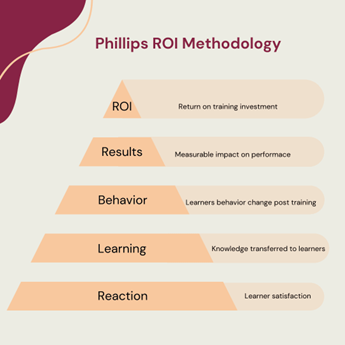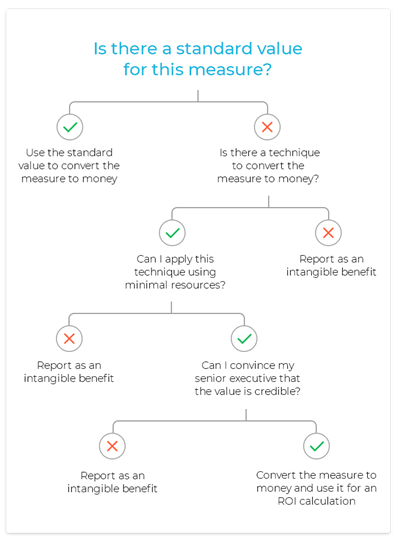How to Measure Return on Investment from a Learning Program

Now more than ever, return on investment (ROI) is vital to businesses of all sizes. Firstly, you must accurately calculate the ROI you will achieve from a project to gain approval. Then, ROI needs to be measured to demonstrate you have met or exceeded your goals.
ROI within a business case must be aligned with monetary values as much as possible. To gain approval for a learning program, the business wants to know what financial gains there will be.
Challenges of measuring ROI
For learning and development teams, predicting and measuring ROI is difficult. Understandably, ROI is aligned with financial gain for the business. And although the benefits of learning and development are clear, aligning them to a monetary value is complicated. Moreover, a learning program can contribute to the business indirectly or the true benefits can accrue over the long term. These factors mean that getting significant investment for new learning and development programs is complex.
How to measure ROI
As we have established, businesses want to see a monetary ROI value to justify learning and development spend. Once implemented, continued ROI measurement and reporting are vital for continued investment.
The challenge is every learning program is different, so it is difficult to use an ROI tool that fits all scenarios.
That said, there is certainly room in your ROI calculations for the best-known tool in the industry, the Phillips ROI Model.
Phillips developed his methodology in the 2000s, which builds on the original Kirkpatrick Model, which was developed in the 1950s, to include ROI. It compares the program’s total cost to its total monetary benefits, calculated as a cost/benefit ratio.

To achieve this, you need to isolate the training benefits and eliminate any non-training factors that may have contributed to the business impact. For example, competitive environment and seasonal effects that temporarily contribute to business improvements.
Calculating Return on Investment
Phillips ROI calculation is:
ROI = (Total Program Benefits – Total Program Costs ROI/Total Program Costs) x 100%
For example, let us assume that we are going to measure the effectiveness of a training program on health and safety for 50 people. We know that because of the program, the number of accidents has been reduced by 20 throughout the year. This has directly increased the company’s revenue by £100,000 per year. The total cost of the program was £50,000.
So, the benefit-cost ratio (BCR) is: £100,000/£50,000 = 2. In other words, for each £1 spent on the training program, £2 is returned.
Using the Phillips ROI calculation, the ROI of the program is calculated as so:
(£100,000 – £50,000/£90,000) x 100% = 55%
This means that every £1 spent on the program is returned and an additional £0.55 is returned as a profit.
Read the in-depth guide to Phillips ROI Model
Assigning Monetary Values to Tangible Learning Outcomes
It is easy to do an ROI calculation with sample numbers for an abstract example but in practice, it is a complex exercise to put monetary values on learning outcomes. Unfortunately, to build a successful business case and a successful learning program it is crucial you get an accurate ROI. That means selecting metrics that will accurately show the benefits of your program.
Hard data that can be converted easier include:
- Additional sales: Profit from these sales
- Employee time savings: Cost of the saved time calculated based on the average rate per hour
- Reduction of equipment downtime: Can be calculated in comparison with the results of the past periods
- Reduction of employee turnover: Money that you save on recruitment and onboarding
- Quality improvement: Money that was saved thanks to reducing the number of defective items
- Reduced costs: Online courses eliminate travel expenses and the time it takes to travel to and from the learning venue.
Further Reading: The Bottomline on ROI, Patricia Pulliam Phillips
Identifying and Reporting on the Intangible Benefits
Whilst every effort should be made to assign a monetary value to as many learning outcomes as possible, sometimes it cannot be done. Most learning programs will have intangible benefits that fall into this category. For example, finding metrics to demonstrate how your learning program has improved the public image of your organisation or how it enhanced the company culture is difficult.
The challenge is this soft data is subjective so even with the best intentions, the data is often inaccurate and not credible.
If in any doubt, the ROI Institute offers some guidance: 
The Impact of Digital Learning
The rise of digital learning, or e-learning, as part of a fully online learning program or a blended learning approach makes calculating ROI an easier task. Digital learning programs run through a Learning Management System (LMS) so you can document, track, report, automate and deliver your training program online.
Another consideration is learning content, when done well, can be used for years after the program launch. This long-term usage of learning content makes an ROI calculation more favourably than single-use learning content such as traditional classroom-based learning.
Summary
It is essential for any learning program to demonstrate value for the business with both tangible and intangible benefits. Predicting ROI to ensure the program is approved and then measuring and reporting ROI to establish it as part of your ongoing learning strategy is challenging but achievable with the right support and approach.
Digital learning via an LMS undoubtedly makes measuring and reporting hard data easier. It also means the system administrator has a wider choice of data to track and report on.
The global workforce is continually evolving. A multigenerational workforce and a shorter shelf life for knowledge have placed a premium on reskilling and upskilling. It means there is ever-increasing importance on attracting, nurturing, and retaining the best talent for your organisation.
The LMS offers your end users a centralised place for learning content to ensure seamless learning is accessible anytime and anywhere. Administrators can create personalised learning courses or learning journeys for individuals, teams or company-wide and track and report on progress using their choice of metrics.
How Sify Can Help
Sify Digital Learning is a specialist digital learning partner that offers the complete learning solution you need to attract, nurture, and retain the best business talent.
A successful learning program is an evolving journey because you are dealing with a constantly changing audience: your employees. Whether your goal is to boost employee productivity, reduce staff turnover or improve company culture or a combination of all three, Sify can help.
We provide the two fundamental components of a successful digital learning program: the LMS and the learning content it holds whether it is Off the Shelf and Custom content.
Book a discovery call to explore how Sify can partner with you to achieve your learning and development goals.



